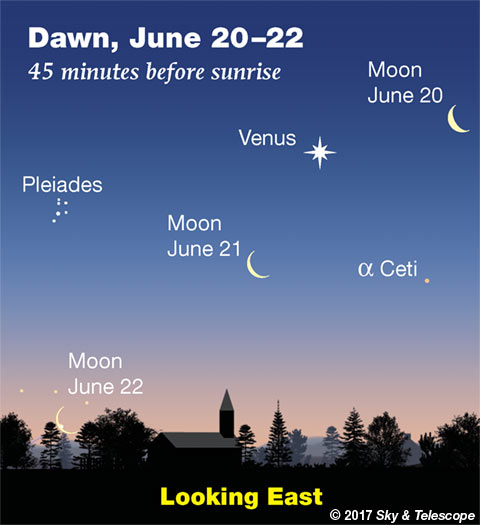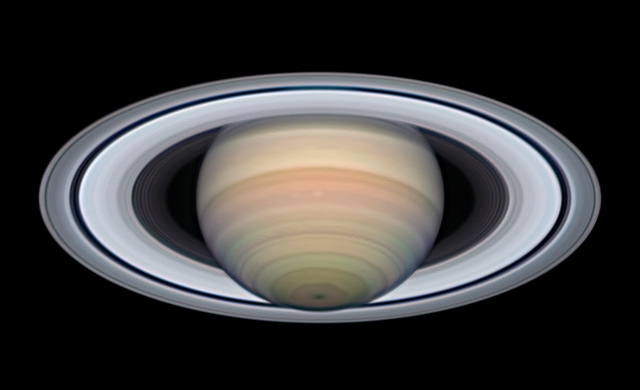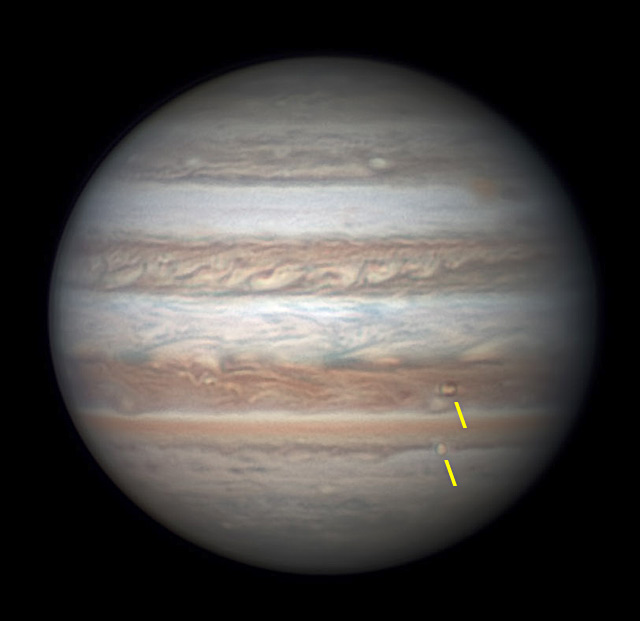Friday, June 16
• By the time it's fully dark this week, Altair is shining well up in the east. A finger-width above it or to its upper left is its little sidekick Tarazed (Gamma Aquilae), actually an orange giant that's far in the background. Altair is 17 light-years from us; Tarazed is about 460.
Saturday, June 17
• The last-quarter Moon rises late tonight, around 1 a.m. daylight-saving time. Watch for it to breach the horizon to the lower right of the Great Square of Pegasus.
Sunday, June 18
• Here it is almost summer. But as twilight fades, look very low in the north-northwest for wintry Capella very out of season. The farther north you are, the higher it will appear. You may need binoculars. If you're as far north as Portland or Montreal, Capella is actually circumpolar.

Monday, June 19
• A double shadow transit occurs on Jupiter tonight from 10:04 to 10:38 p.m. EDT, when both Io and Europa are casting their tiny black shadows onto opposite sides of the planet's face.
• Dawn on Tuesday the 20th find Venus shining to right of the waning crescent Moon, as shown here.
Tuesday, June 20
• This is "Midsummer's Night," the shortest night of the year in the Northern Hemisphere. Astronomical summer begins at the solstice, 12:24 a.m. EDT (4:24 UT) on the 21st; that's 9:24 p.m. on the 20th PDT.
The term "Midsummer's Night" is left over from when the seasons were commonly defined as beginning and ending around the cross-quarter days. Be like your ancestors — build a bonfire tonight and organize some all-night revelry while magic is afoot. Dawn will come soon enough — when you'll see Venus over the crescent Moon, as shown above.
Wednesday, June 21
• Do you know about the dark Propeller in the M13 star cluster in Hercules? With no Moon in the sky, take advantage of the dark to visit Sue French's six favorite summer deep-sky objects, which she features in the July Sky & Telescope, page 54.
Thursday, June 22
• Leo the Lion is a constellation of late winter and spring. But he's not gone yet. As twilight ends, look due west, rather low, for Regulus, his brightest and now lowest star: the forefoot of the Lion stick figure. The Sickle of Leo extends upper right from Regulus. The rest of the Lion's constellation figure extends for almost three fist-widths to the upper left, to end with his tail star, Denebola, the highest. He's walking down to the western horizon.
Friday, June 23
• This is the time of year when, after dark, the dim Little Dipper floats straight upward from Polaris (the end of its handle) — like a helium balloon on a string escaped from some summer evening party. Through light pollution, however, all you may see of the Little Dipper are Polaris at its bottom and Kochab, the lip of the Little Dipper's bowl, at the top.
• New Moon (exact at 10:31 p.m. EDT).
Saturday, June 24
• This is the time of year when the two brightest stars of summer, Arcturus and Vega, are equally high overhead soon after dark: Arcturus in the southwest, Vega toward the east.
Arcturus and Vega are 37 and 25 light-years away, respectively. They represent the two commonest types of naked-eye stars: a yellow-orange K giant and a white A main-sequence star. They're 150 and 50 times brighter than the Sun, respectively — which, combined with their nearness, is why they dominate the evening sky.
________________________
Want to become a better astronomer? Learn your way around the constellations! They're the key to locating everything fainter and deeper to hunt with binoculars or a telescope.
This is an outdoor nature hobby. For an easy-to-use constellation guide covering the whole evening sky, use the big monthly map in the center of each issue of Sky & Telescope, the essential guide to astronomy.

Once you get a telescope, to put it to good use you'll need a detailed, large-scale sky atlas (set of charts). The basic standard is the Pocket Sky Atlas (in either the original or Jumbo Edition), which shows stars to magnitude 7.6.
Next up is the larger and deeper Sky Atlas 2000.0, plotting stars to magnitude 8.5; nearly three times as many. The next up, once you know your way around, is the even larger Uranometria 2000.0 (stars to magnitude 9.75). And read how to use sky charts with a telescope.
You'll also want a good deep-sky guidebook, such as Sue French's Deep-Sky Wonders collection (which includes its own charts), Sky Atlas 2000.0 Companion by Strong and Sinnott, or the bigger Night Sky Observer's Guide by Kepple and Sanner.
Can a computerized telescope replace charts? Not for beginners, I don't think, and not on mounts and tripods that are less than top-quality mechanically (meaning heavy and expensive). And as Terence Dickinson and Alan Dyer say in their Backyard Astronomer's Guide, "A full appreciation of the universe cannot come without developing the skills to find things in the sky and understanding how the sky works. This knowledge comes only by spending time under the stars with star maps in hand."
This Week's Planet Roundup


Mercury is hidden in the glare of the Sun.
Venus (magnitude –4.3) shines bright in the east during dawn. A telescope shows it just on the gibbous side of dichotomy (half-lit phase).
Mars is lost in the sunset.
Jupiter (magnitude –2.1, in Virgo) shines high and bright in the southwest during evening. Spica, magnitude +1.0 and noticeably bluer, glitters 10° left of it. In a telescope, Jupiter has shrunk to 39 arcseconds wide.
Saturn (magnitude 0.0, in southern Ophiuchus) is just past opposition. It glows yellowish low in the southeast in twilight, 15° left of fiery Antares. By about midnight Saturn is at its highest in the south, in the steadiest air for telescopic observing.
Uranus (magnitude 5.9, in Pisces) is low in the glow of dawn.
Neptune (magnitude 7.9, in Aquarius) is well up in the southeast before the first light of dawn.
__________________________
All descriptions that relate to your horizon — including the words up, down, right, and left — are written for the world's mid-northern latitudes. Descriptions that also depend on longitude (mainly Moon positions) are for North America.
Eastern Daylight Time (EDT) is Universal Time (UT, UTC, or GMT) minus 4 hours.
__________________________
"This adventure is made possible by generations of searchers strictly adhering to a simple set of rules. Test ideas by experiments and observations. Build on those ideas that pass the test. Reject the ones that fail. Follow the evidence wherever it leads, and question everything. Accept these terms, and the cosmos is yours."
— Neil deGrasse Tyson, 2014
"Objective reality exists. Facts are often determinable. Vaccines do stop diseases. Carbon dioxide does warm the globe. Science and reason are no political conspiracy; they are how we discover reality. Civilization's survival depends on our ability, and willingness, to do so."
— Alan MacRobert, your Sky at a Glance editor
"Facts are stubborn things; and whatever may be our wishes, our inclinations, or the dictates of our passions, they cannot alter the state of facts and evidence."
— John Adams, 1770
 0
0








Comments
You must be logged in to post a comment.